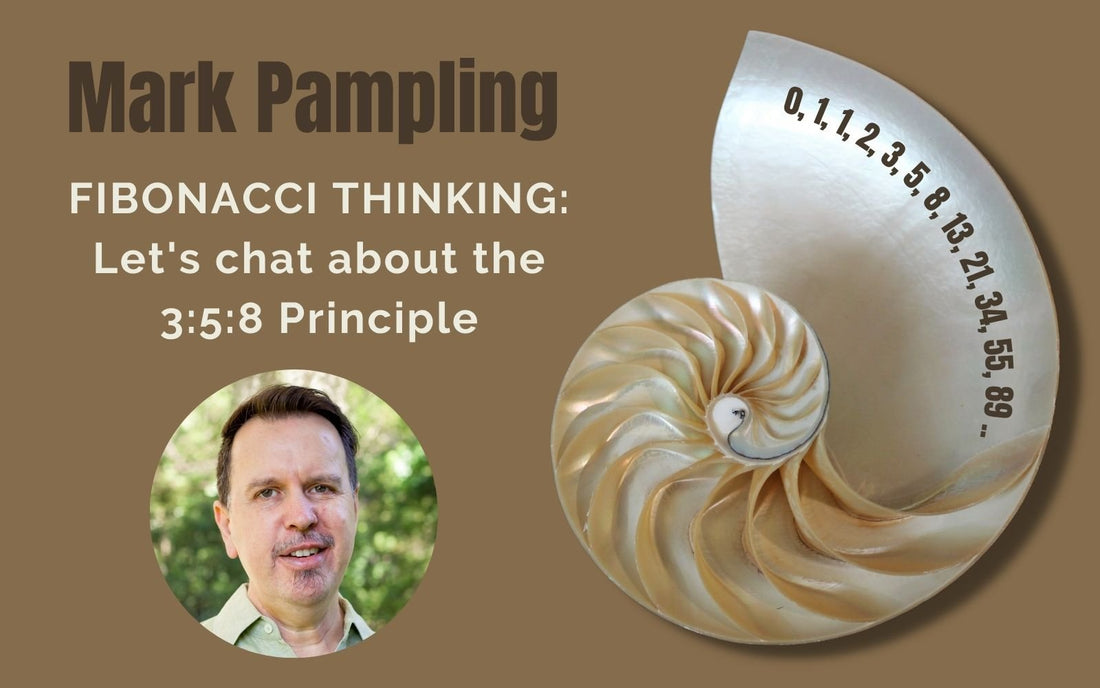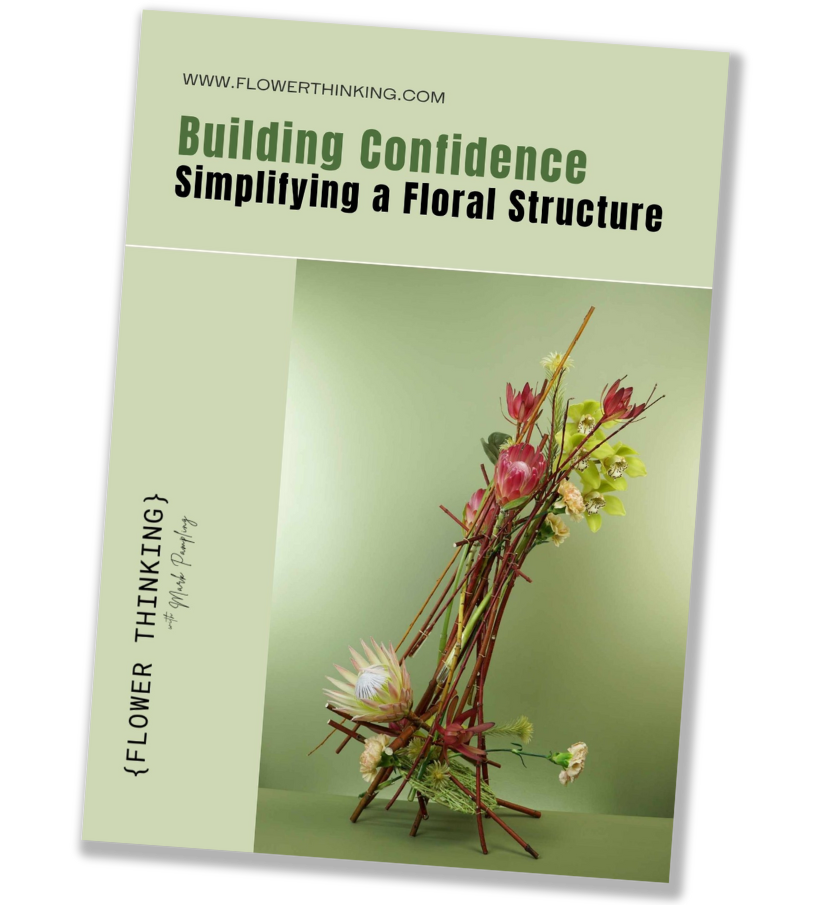
Let's Chat About the 3:5:8 Principle
Share
A Chat About The Principle of 3:5:8
The term "3-5-8" is often spoken about in floral design discussions. What is it? Why is it used in flower arrangements?
What is it?
3:5:8 is a design principle concerned with proportions. It is known by various names and is based on a sequence of numbers named after the Italian mathematician, Leonardo Fibonacci. The sequence had been recognised and acknowledged for many centuries before Fibonacci elevated it to prominence in Western mathematics in the 13th Century.
The Fibonacci sequence is a relatively straightforward concept, and generally written as follows ….
0, 1, 1, 2, 3, 5, 8, 13, 21, 34, 55, 89, 144 ….
The sequence continues after the first two numbers are added together: 0 + 1 = 1. Similarly, each subsequent number in the series is the result of adding the previous two numbers in the sequence:
0 + 1 = 1
1 + 1 = 2
1 + 2 = 3
2 + 3 = 5
3 + 5 = 8
5 + 8 = 13 …. and so on …
Mathematics for floral design? Sounds complicated?
The sequences can also be identified outside of mathematics, including biological contexts – it has fascinated botanists, biologists, musicians, artists and designers for centuries because it is often represented in natural growth patterns. The same number series can be found in the growth patterns of many living things and naturally occurring systems.
The Fibonacci sequence represented as a grid of blocks:

If an arc is drawn from one corner of each square to the diagonally opposite corner, from the smallest squares outward, the arcs become a spiral. The Golden Spiral – a phenomenon that can be observed throughout nature. The sequence can be seen in many flowers and plant materials (pineapples, pine cones, sunflower seed heads, artichokes, unfurling fern fronds, etc.) and natural objects (Nautilus shells, etc.).

The basis of the Fibonacci sequence is also a common factor in determining proportions in the study and making of art, where the concept is referred to variously as the Golden Mean, the Golden Rule, Golden Proportion, Divine Proportion, etc.

Why would art and design use the sequence?
Scholars identified that the relationship between the Fibonacci sequence and nature often led to a common recognition or appreciation of 'beauty'. Without getting too mathematical, the ratio between each consecutive number is relatively the same. If you take two subsequent numbers from the sequence and divide the larger number by the smaller number you will get a result that approximates 1.618. This number is called the Golden Ratio (also called ‘Phi’). This ratio can be broadly applied to proportion in design with the goal being 'beauty'. The external proportions (dimensions) and internal proportions (volumes) which are more likely to produce beauty can be determined by using the Golden Ratio. In floral design, this ratio is widely represented by the term 3:5:8, which is plucked from the Fibonacci sequence.
Why is it used in flower arrangements?
By applying the recurring proportion found in the number sequence, an artist or designer is more likely to achieve an aesthetically pleasing result. Hence, the principle of 3:5:8 can be considered a guide to realising successful, or harmonious, proportions.

Is it a strict rule?
There are no absolute rules for proportion. There are guidelines, such as 3:5:8, but there are no rules that are ‘set in stone’. Proportions are always affected by the qualities of the various elements that are combined to create a design. Changing one element will impact upon the other chosen elements and the overall effect. The intended outcome and purpose of a design must always be considered in unison with considering and assessing its proportions.
How do you use the 3:5:8 principle?
Classical Western flower arranging has traditionally employed the proportional relationship of one third to two thirds (1/3 and 2/3).
For example, general guidelines on proportion suggest the height of a vertical arrangement should be one and a half times the width of the arrangement (making the width two thirds of the height). The height would be written as 1.5 (ratio).
Arrangement proportions and ratios represented in simple sketches:
 An arrangement in a container, proportions and ratios represented in simple sketches:
An arrangement in a container, proportions and ratios represented in simple sketches:

In these illustrations and proportions, you can observe number from the Fibonacci sequence in use (3, 5 & 8).
European floral design has more commonly used the proportional relationship of 3:5:8. This relationship is taken directly from the Fibonacci sequence. The relationship is represented by the Golden Ratio number of 1.618 … which is very close to the classical Western thinking of 1.5. The Western way of thinking about proportional relationships may well, in fact, have been derived from the Golden Ratio.
Proportions can be considered either internally (inside a design’s silhouette) or externally (the dimensions of a design). Internal proportions refer to the amounts/volumes of each of the elements being used (colours, lines, textures, forms, spaces), or the volume of particular areas within a design – such as the amount of space occupied by and/or the visual weight of the focal areas within a design.
English flower arranging has historically placed more emphasis on the relationships in the external proportions of a design (the dimension and silhouettes), whereas European flower arranging has had a greater focus on the relationships between the internal proportions, especially in the creation of groupings and focal areas.
The 3:5:8 way of thinking about internal proportions is particularly applicable to contemporary designing. In contemporary designing the creation of groupings and focal areas often takes precedent over the creation of the outline or silhouette of the arrangement.

So, 3:5:8 can be applied to grouping materials?
Commonly, there will be three major groupings:
Dominant Group
Contrasting Group
Subordinate Group
3:5:8 proportions can be applied to the relationship between these groups:
Dominant (8): Contrasting (5): Subordinate (3)
It is not necessary to always have the three groupings present. For example, sometimes the absence of the Contrasting group can heighten the tension between the Dominant and the Subordinate groups.
3:5:8 proportions can also be applied to the spaces between the groupings, producing an uneven distribution which can also add a more contemporary feel to a design. The diagram below demonstrates the application of the 3:5:8 proportions to the size/impact and spacing of groupings within a design (regardless of the outline/form/silhouette of the arrangement).
Groups:
A = Dominant group (8)
B = Contrasting group (5)
C = Subordinate group (3)
Spaces:
Dominant space – between B and C (8)
Contrasting space – between B and A (5)
Subordinate space – between A and C (3)
Group A is placed asymmetrically between Group B and Group C at axis point * (5:3)
What do top floral designers say about the 3:5:8 Principle?
German Master Florist, Gregor Lersch, uses a phrase that makes applying 3:5:8 proportions easier – "Less : More : Maximum".
Essentially, this phrase converts numbers into words.
3 : 5 : 8 = Less : More : Maximum

Which parts of a design does the principle apply to?
When considering the dimensions of a design, or the proportions of the colours, or the impact/size of the focal areas, etc. it can be useful to ask:
Which is the smallest dimension (less/3), which is the secondary dimension (more/5) and which is the greatest dimension (maximum/8)?
Which colour is the highlight (less/3), which is the secondary colour (more/5) and which is the dominant colour (maximum/8)?
Which area of interest is the most dominant (maximum/8), which area contrasts with the dominant area (more/5) and which area is subordinate (less/3)?
Remember, not all three proportions need to be present for a successful design – you may have a dominant proportion and a subordinate proportion, with no contrasting proportion, to create more interesting tension. E.g. using two colours in a complimentary colour scheme, red and green; using red as the dominant colour (maximum/8) and a much reduced amount of green as the subordinate colour (less/3). That is, you can use maximum and less, without needing to add more!
Can I use the 3:5:8 Principle in other ways?
Thinking in a ‘3:5:8 way’ can lead you to consider different or new possibilities and extend your designing.
You can extend the relationships between the proportions and add more tension, drama and interest to your designs. As mentioned previously, you can omit one of the proportions to increase impact – e.g. use 3 and 8, and leave out 5. You can also stretch the relationship between the proportions and stay true to the basic principles. All numbers in the Fibonacci sequence are related and can therefore be considered for inclusion. We can extend or combine the 3:5:8 proportions to include, for example:
2:2:5
2:2:8
1:1:8
2:3:13
The possibilities are endless, and also challenging. When you change the proportion and use of one element, its impact on the other elements, and overall harmony of the design must be carefully considered.
How could I use the 3:5:8 principle in competition work?
Frequently in competitions or bench work we are assigned dimensions to work within. We may be given a maximum height, such as 130cm. Using 3:5:8 proportions we can work backwards to find dimensions that will give us the best chance of achieving ‘ideal beauty’ (excellent proportions).
Starting with the given dimension (130cm) we can divide/multiple it by Phi (1.618 approximately) and find all the respective dimensions to fit into the extended Fibonacci sequence – giving us more starting options to play with proportion. We can set the maximum height of 130cm against the Fibonacci sequence and establish other dimensions.

With a maximum height limit of 130cm, using the greatest dimension (210cm) is likely to invite disqualification.
Creating a design that is 130cm high (at maximum), 80cm wide and 50cm deep can give us a good chance of working in good proportions.
Taking a more contemporary approach:
Creating a design that is 130cm high (at maximum), 30cm wide and 20cm deep can give us a more contemporary result. Combining these stretched dimensions with three focal areas that are in the extended proportion of 1:2:13 can also create a sense of beauty that is surprising, captivating and dynamic.

Watch here:
References:
Form Linear Design: A Guide for Florists & Floral Designers
The Society of Floristry Ltd 2009
ISBN 978-0-9553043-1-6
www.societyoffloristry.org
Searching for Design: with Fibonacci and Phi
Dan Harwell
Golden Spiral Publishing 1995
ISBN 0-9648677-0-2
(Out of Print – 2nd hand copies available online)

